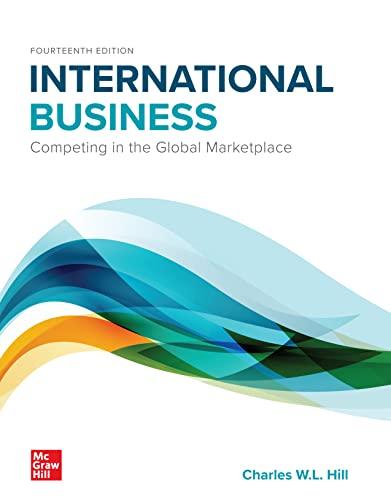Question
Mwangaza Metals Ltd. Fabricates steel products for export to the COMESA region. The products go through three processing departments: forming, machining and finishing. The following
Mwangaza Metals Ltd. Fabricates steel products for export to the COMESA region. The products go through three processing departments: forming, machining and finishing.
The following information relates to operations for the year ended 31 October 2010.
1.Budget manufacturing costs for the year ended 31 October 2010 were as follows
Departments
Forming
Machining
Finishing
Total
Sh.
Sh.
Sh.
Sh.
'000'
'000'
'000'
'000'
Direct materials
340,000
Direct labour
80,000
40,000
120,000
240,000
Manufacturing overheads
20,000
80,000
60,000
160,000
2.The actual manufacturing costs incurred for the year ended 31 October
Departments
Forming
Machining
Finishing
Total
'000'
'000'
'000'
'000'
Direct materials
360,000
Direct labour
88,000
38,000
144,000
270,000
Manufacturing overheads
24,000
72,000
78,000
174,000
3.While there were no finished goods or work-in-progress inventories at the beginning of the year, stocks on 31 October 2010 were made up as follows:
Finished goods
ksh.121,000,000
The above balances include actual direct materials, direct labour and absorbed overhead costs.
4.Manufacturing overhead costs are absorbed into products on the basis of direct labour costs, at rates pre-determined at beginning of the year, using the annual budgeted data.
Two alternatives of absorbing overheads could be employed:
Use a single factory wide manufacturing overhead rate.
Use separate departmental manufacturing overhead rates.
5.The policy of the company is to dispose of over (under) absorbed overheads at the year-end by allocating the amount between ending inventories and cost of goods sold in proportion to their unadjusted cost balances.
Required:
(a)Using the separate departmental manufacturing overhead rates:
(i)Determine the total under/over absorbed overheads for the year.
(ii)Allocate the over/under absorbed overheads to the relevant accounts.
(iii)Prepare a journal entry to record the disposal of the over/under absorbed overheads.
(b)A particular order code named E20, from a customer was worked on and completed during the year. The following costs were incurred in relation to the order.
Ksh.
Ksh.
Direct materials
3,000,000
Direct labour:
Forming
400,000
Machining
380,000
Finishing
480,000
1,260,000
Required:
Using the factory wide absorption rate, determine total overhead applied to the order (E20).Mwangaza Metals Ltd. Fabricates steel products for export to the COMESA region. The products go through three processing departments: forming, machining and finishing.
The following information relates to operations for the year ended 31 October 2010.
1.Budget manufacturing costs for the year ended 31 October 2010 were as follows
Departments
Forming
Machining
Finishing
Total
Sh.
Sh.
Sh.
Sh.
'000'
'000'
'000'
'000'
Direct materials
340,000
Direct labour
80,000
40,000
120,000
240,000
Manufacturing overheads
20,000
80,000
60,000
160,000
2.The actual manufacturing costs incurred for the year ended 31 October
Departments
Forming
Machining
Finishing
Total
'000'
'000'
'000'
'000'
Direct materials
360,000
Direct labour
88,000
38,000
144,000
270,000
Manufacturing overheads
24,000
72,000
78,000
174,000
3.While there were no finished goods or work-in-progress inventories at the beginning of the year, stocks on 31 October 2010 were made up as follows:
Finished goods
ksh.121,000,000
The above balances include actual direct materials, direct labour and absorbed overhead costs.
4.Manufacturing overhead costs are absorbed into products on the basis of direct labour costs, at rates pre-determined at beginning of the year, using the annual budgeted data.
Two alternatives of absorbing overheads could be employed:
Use a single factory wide manufacturing overhead rate.
Use separate departmental manufacturing overhead rates.
5.The policy of the company is to dispose of over (under) absorbed overheads at the year-end by allocating the amount between ending inventories and cost of goods sold in proportion to their unadjusted cost balances.
Required:
(a)Using the separate departmental manufacturing overhead rates:
(i)Determine the total under/over absorbed overheads for the year.
(ii)Allocate the over/under absorbed overheads to the relevant accounts.
(iii)Prepare a journal entry to record the disposal of the over/under absorbed overheads.
(b)A particular order code named E20, from a customer was worked on and completed during the year. The following costs were incurred in relation to the order.
Ksh.
Ksh.
Direct materials
3,000,000
Direct labour:
Forming
400,000
Machining
380,000
Finishing
480,000
1,260,000
Required:
Using the factory wide absorption rate, determine total overhead applied to the order (E20).
Step by Step Solution
There are 3 Steps involved in it
Step: 1
a i Determining departmental manufacturing overhead rates Forming department Budgeted overhead Sh 20...
Get Instant Access to Expert-Tailored Solutions
See step-by-step solutions with expert insights and AI powered tools for academic success
Step: 2

Step: 3

Ace Your Homework with AI
Get the answers you need in no time with our AI-driven, step-by-step assistance
Get Started


